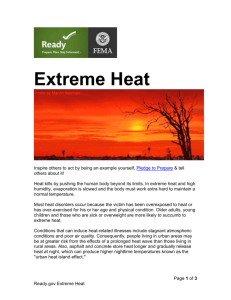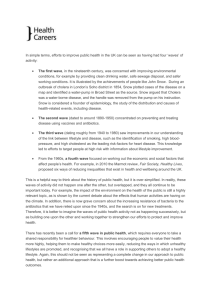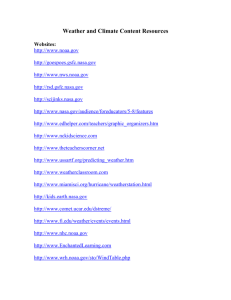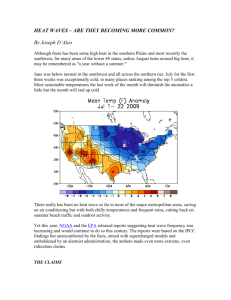Science - Cal State LA - Instructional Web Server
advertisement
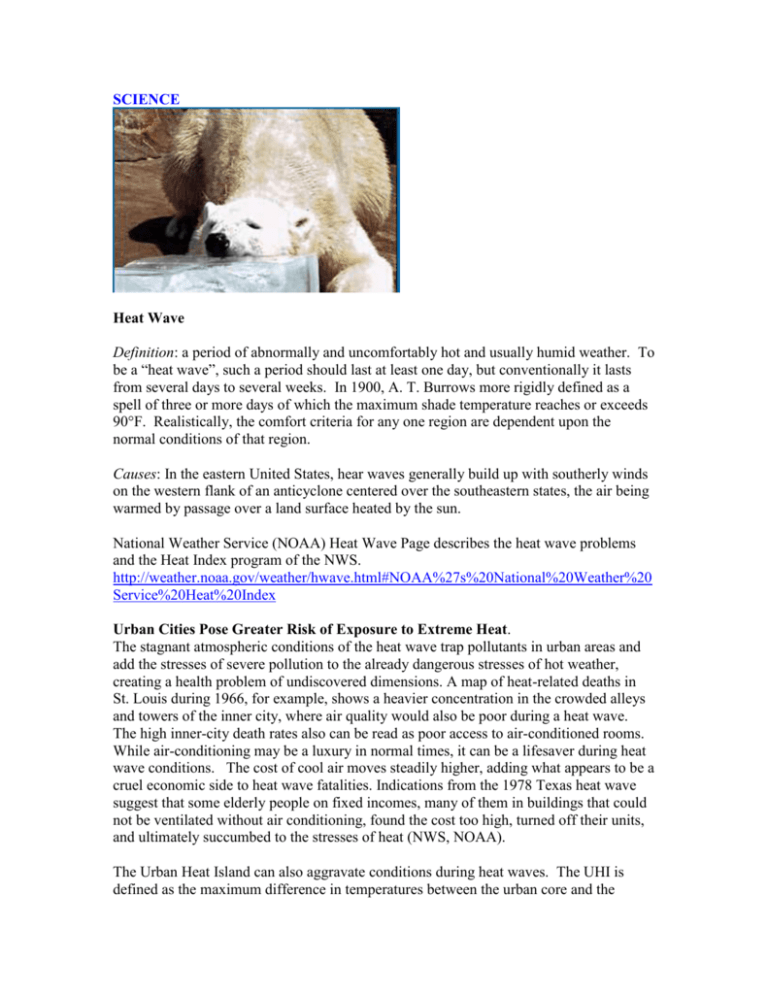
SCIENCE Heat Wave Definition: a period of abnormally and uncomfortably hot and usually humid weather. To be a “heat wave”, such a period should last at least one day, but conventionally it lasts from several days to several weeks. In 1900, A. T. Burrows more rigidly defined as a spell of three or more days of which the maximum shade temperature reaches or exceeds 90°F. Realistically, the comfort criteria for any one region are dependent upon the normal conditions of that region. Causes: In the eastern United States, hear waves generally build up with southerly winds on the western flank of an anticyclone centered over the southeastern states, the air being warmed by passage over a land surface heated by the sun. National Weather Service (NOAA) Heat Wave Page describes the heat wave problems and the Heat Index program of the NWS. http://weather.noaa.gov/weather/hwave.html#NOAA%27s%20National%20Weather%20 Service%20Heat%20Index Urban Cities Pose Greater Risk of Exposure to Extreme Heat. The stagnant atmospheric conditions of the heat wave trap pollutants in urban areas and add the stresses of severe pollution to the already dangerous stresses of hot weather, creating a health problem of undiscovered dimensions. A map of heat-related deaths in St. Louis during 1966, for example, shows a heavier concentration in the crowded alleys and towers of the inner city, where air quality would also be poor during a heat wave. The high inner-city death rates also can be read as poor access to air-conditioned rooms. While air-conditioning may be a luxury in normal times, it can be a lifesaver during heat wave conditions. The cost of cool air moves steadily higher, adding what appears to be a cruel economic side to heat wave fatalities. Indications from the 1978 Texas heat wave suggest that some elderly people on fixed incomes, many of them in buildings that could not be ventilated without air conditioning, found the cost too high, turned off their units, and ultimately succumbed to the stresses of heat (NWS, NOAA). The Urban Heat Island can also aggravate conditions during heat waves. The UHI is defined as the maximum difference in temperatures between the urban core and the surrounding rural lands. The replacement of vegetation by streets, buildings and asphalt, often lead to a greater absorption of sunlight during the day and a slow release of heat during the nighttime. Rooftop temperatures can reach over 160 F, as shown in a NASA overflight of Salt Lake City below. (source: MSFC, NASA) More information on the urban heat island can be obtained from: Marshall Space Flight Center, http://wwwghcc.msfc.nasa.gov/urban and Livermore-Berkeley Lab, http://eetd.lbl.gov/HeatIsland/LEARN/ . Heat Index. Considering the death toll due to heat waves, the National Weather Service has stepped up its efforts to alert more effectively the general public and appropriate authorities to the hazards of heat waves -- those prolonged excessive heat/humidity episodes. Based on the latest research findings, the NWS has devised the "Heat Index" (HI), (sometimes referred to as the "apparent temperature"). The HI, given in degrees Fahrenheit, is an accurate measure of how hot it really feels when the relative humidity (RH) is added to the actual air temperature. To find the Heat Index, look at the Heat Index Chart. As an example, if the air temperature is 95°F (found on the left side of the table), and the relative humidity is 55% (found at the top of the table), the HI -- or how hot it really feels -- is 110°F. This is at the intersection of the 95° row and the 55% column. (source: Central Regional Headquarters, NWS, NOAA) By clicking on the table above, you can calculate the Heat Index and the relative humidity for any temperature and dew point temperature. Activities: 1. Click on the table above and fill in the blanks below: Temp (F) 50 70 90 90 Dew Point (oF) 50 50 50 70 Heat Index Relative Humidity (%) How does increasing temperatures affect the Heat Index? If dew point stays the same, what happens to relative humidity as temperature increases? What happens to the Heat Index as dew point temperatures increase? 2. Calculate the Heat Index for your location for the warmest time of today.

